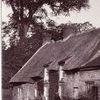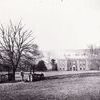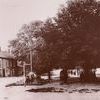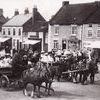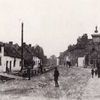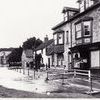Steeped in history and unspoilt by modern times, Thornton–Le-Dale has a long and fascinating history dating back to at least the Neolithic period. The high ground to the north of the village was farmed by Neolithic man, who left their mark in the shape of tumuli and a cart burial at Pexton that has been dated to 300BC.
It is believed that The Angles, who conquered Yorkshire between AD 500-540, must have given Thornton its name, the countryside was thickly wooded so the name suggests a place surrounded by thorn bushes.
The Square
The Square is in the centre of the village and here on the village green, you will see the Market Cross and Stocks.
Following the Norman Conquest, Thornton Manor was given to the Crown and later William gave it to his sister Adelaide whose third husband was the Count Odo, the founder of the House of Albermarle.
In 1281, the Manor was in the hands of John De Easton and King Edward I granted him a weekly market on the village green. The market no longer operates but the market cross and stocks, which were last used for public punishment of wrongdoers in 1874, remain.
Today The Green is a focal point of the village, hosting Sunday afternoon band concerts in the summer and the annual switch-on ceremony of the Christmas lights in December.
All Saints Church
Just beyond The Hall and overlooking the village on raised ground, is the fascinating Grade 2 listed building, All Saints Church.
It is accepted that there was a church here in the remote past, firstly from the fact that the bowl of the font is Norman and has been dated as late 12th century and secondly because there was a parson in the village about the same time. Except for the font, the Norman church has entirely disappeared and in the 14th century, a new church with a porch was erected from Chancel to Tower.
Despite alterations been made to the fabric of the church, including roof, floor and windows in 1681, one hundred and ninety years later, this building was again in a serious condition. Further restoration work including rebuilding the Chancel and the Vestry commenced during 1865 with the corner stone been laid on 20th June. The almost new church was first used for service in October 1866 when consecrated by the Archbishop of York.
The Church is the resting place of Sir Richard Cholmeley, the Black Night of the North who was buried in the chancel in 1583. In the churchyard is the memorial of Matthew Grimes, a soldier who was one of Napoleon’s guards on St. Helena.
St. Hildas Church, Ellerburn
St Hilda's Church is a Grade II listed building, situated just one mile from Thornton- Le- Dale in the valley of Ellerburn. It is believed that in the early days of Christianity the monks of Whitby Abbey established their first house of worship here and that St Hilda's would originally have been a wooden building with stone churchyard crosses.
The fabric of the Church appears to date back to the early Norman period, although the presence of various stones, notably the Churchyard Cross fragment in the South wall, points to a much earlier date. Many Architects and Archaeologists have visited the site and believe that the Church was originally of Saxon origin.
The churchyard is entered by a large Lych-gate, which was a gift from W.A.Meek. The building was restored between 1904 and 1911 to include a new porch, which contains a very interesting stone carved with a swastika. This sign is known to be the sign of wellbeing and is probably non-Christian in origin. The church contains a number of fascinating and symbolic carvings including fragments of a Saxon cross and other carved stones that are set into the walls of the nave.
There are many interesting historic features inside the Church, including the Font that is a rough circular bowl, likely of 12th century origin and standing on a base made of pillars, some of which were dug up in the 1904 restoration. The octagonal pulpit is from the Jacobean period and has a sounding board and soffit. The pillars of the Chancel Arch have Saint Hilda’s Serpent worked on them and they support an arch, which appears to be of a later date than the pillars.
Alms Houses
The Alms Houses are situated to the left of the main road, between the village green and the bridge.
Thornton Manor passed into the hands of Richard, first Viscount Lumley, through his marriage to Elizabeth Sandys, who was granddaughter of the fourth Lord Latimer. Her maternal grandfather, Lord Latimer of Snape, left land in Thornton, Sinnington, Marton and Pickering to Elizabeth.
Lady Lumley, as she became, died in 1657 aged 80, bequeathing her estates for the creation of a school and almshouses.
The charity built a row of 12 Alms Houses and a Grammar School in the centre of the village. Today the Alms Houses are still in use and are supported by the Lady Lumley’s Charitable Trust.
The Grammar School
Completed in 1670, The Grammar School is situated on the corner of Brook lane and Chestnut Avenue.
Elizabeth, Viscountess Lumley had no children of her own and was determined to assist others in the education of their children so she executed a deed, dated 1657, which stated that a school should be erected in the village for schooling and prayer reading, for children in the parish of Thornton le Dale and Sinnington. There was also to be set on one side, a sum of £10 per annum for five scholars at Oxford and five at Cambridge.
One of the first pupils of this school was John Leng, who graduated BA. At Cambridge in 1686.
The school closed in the early years of the 20th century and is now used by the community for a variety of purposes.
Lady Lumley’s School is now a specialist sports and language college located in Pickering.
Roxby Castle
About a quarter of a mile from the village centre is Roxby Hill, where Roxby Castle once stood. 1st Baronet Hugh Cholmeley, was born at the Castle in 1600 and became a Member of Parliament and a Royalist leader. During the English Civil War, he earned a knighthood and a later a baronetcy, his descendant was Sir Richard Cholmeley who was known as the Great Black Knight of the North.
Except for the disparity of the ground, there are no remains of the castle and nothing to mark the spot. However, Sir Richard Cholmeley is buried in the chancel of Thornton church, where there is a recessed monument with a recumbent figure, believed to be that of his wife.
The Thatched Cottage
This picture-postcard village attracts thousands of tourists each year to see Beck Isle Cottage, which is one of the most photographed homes in the country. Built in the 17th century with a cruck frame and thatched roof, it stands on the banks of the beck and regularly appears on chocolate boxes, jigsaws and calendars.
Railway station
Construction of the Scarborough to Pickering branch line of the railway began in 1879 and took three years to complete. The station opened to passenger traffic on 1 May 1882, and closed on 3 June 1950.
The station remained open for freight traffic to Pickering after the rest of the Forge Valley Line was closed and pulled up. The last traffic into the station was two Presflo wagons of bulk cement for repairs to the village hall.
The station finally closed completely in 1963. The station building was cleared and converted into offices for a company building a gas pipeline to Pickering and later the station site was converted into a caravan site, with the station buildings divided and refurbished as three holiday cottages.
The Mill
Standing along the side of the beck on Priestmans Lane, is The Mill that Squire G.F.G. Hill rebuilt and enlarged in 1919 calling it Victory Mill. In 1921, the Burgess family moved from Kirby Fleetham, near Norhallerton and became famous for making Gold Medal plain flour.
In 1963, the mill was adapted for the manufacture of animal feed.
Should you be interested in reading more, these brief extracts have been taken from ‘The History of Thornton Le Dale’. This fascinating and comprehensive read on the history of the village is written by Reginald Jeffery and Keith Snowden.

